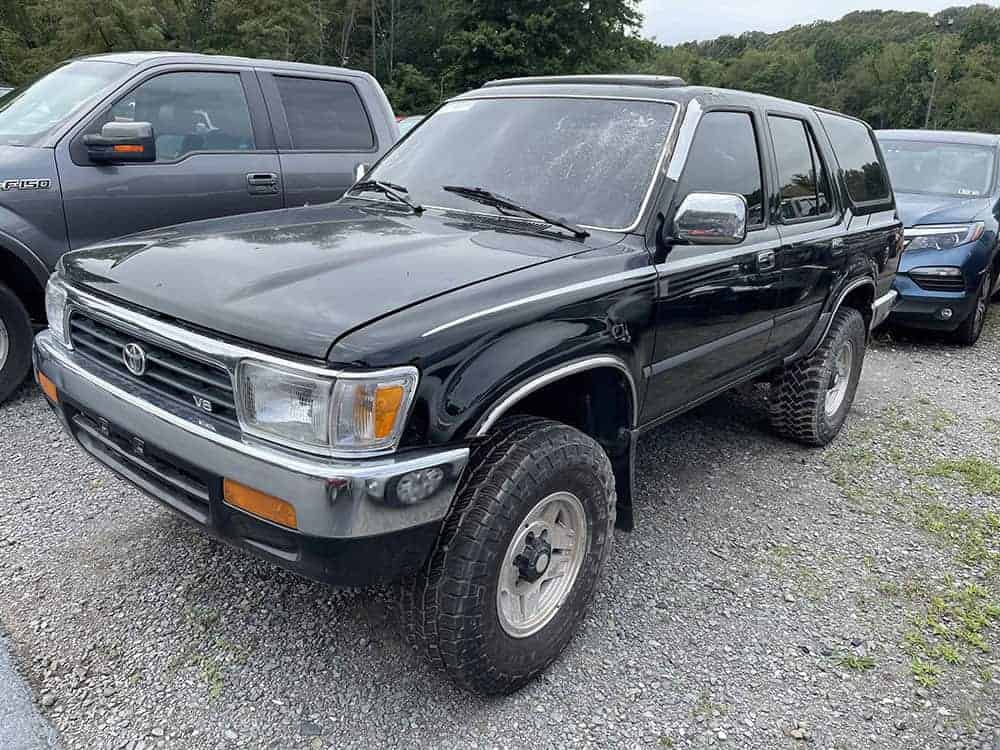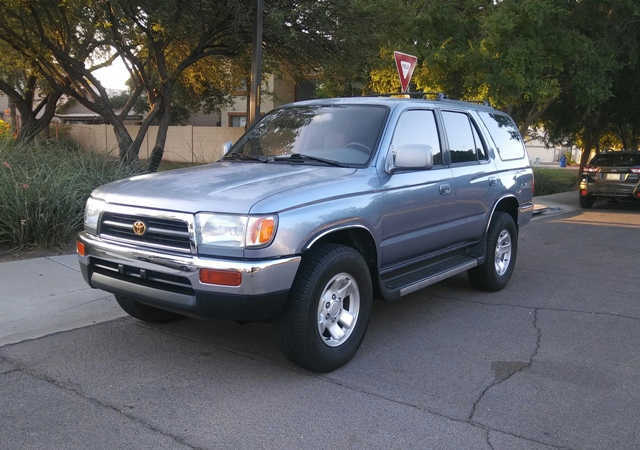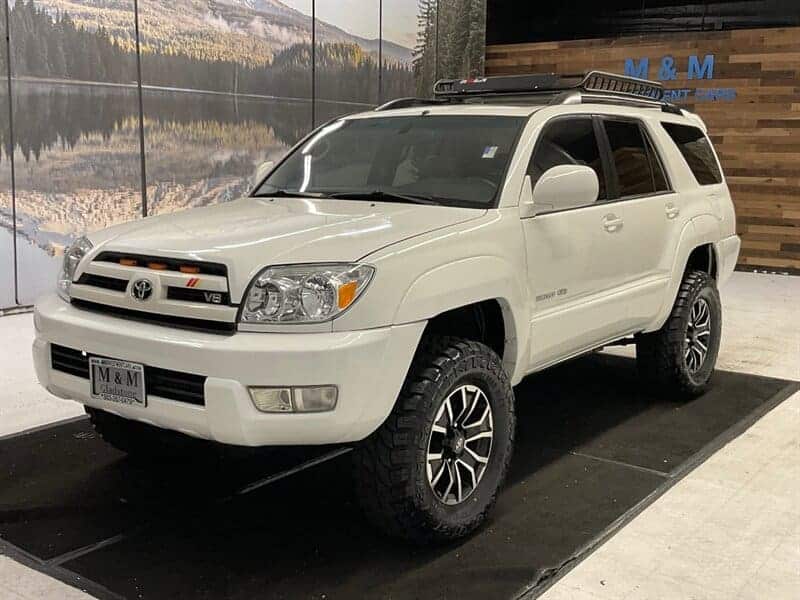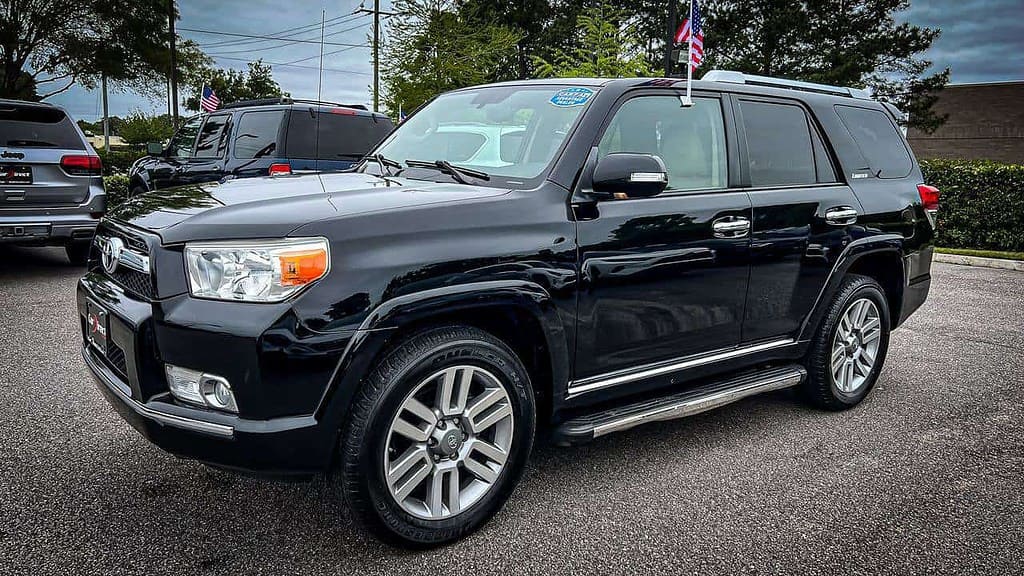What to Look For When Buying a Used Toyota 4Runner

Boasting a solid reputation for reliability and ruggedness, the Toyota 4Runnner is the ultimate midsize SUV! Known for both its solid performance and generous cargo space, this legendary rough-and-tumble dirt-loving machine features a comprehensive safety tech package and no fewer than eight trim levels to suit just about every driver type. It makes for a fantastic choice if you are looking to buy a used Toyota 4Runner thanks to its impressively long life!
However, this doesn’t entirely imply that it’s the perfect car! So, before you spend your hard-earned bucks on a used 4Runner, there are a couple of important things you should know and this comprehensive guide will enlighten you on what to look for when buying a used Toyota 4Runner.
A brief history of the Toyota 4Runner
The Toyota 4Runner is a highly rugged, old-fashion body-on-frame midsize SUV that’s enjoyed lots of popularity in an era filled with flashy car-based SUVs filled to the brim with tech. And while it may not be the most fuel-efficient, high-tech, or comfortable, it’s loved thanks to its unmatched versatility, tough appearance, and off-road prowess.
Currently, in its 5th generation, the 4Runner has stuck to its basic design since its inception in 1984. Most models don’t always carry on for this long before shaking things up. This is a strong indication that this giant Japanese car manufacturer isn’t going to fix what isn’t broken. The 4Runner retains a loyal fan base because it delivers the off-road capability it promises and does so with rock-solid dependability! Continue your reading and learn how far this beastly machine has come!
First Generation (1984-1989)

The 1st 4Runner generation was launched in 1984 as a two-door 4WD SUV. It had a robust front axle, and removable fiberglass shell over its rear section and looked strikingly similar to a modified Hilux pickup truck!
The 4Runner underwent some major evolutions starting in 1985 when its engine was replaced with a fuel-injected version. Again, a year later, its solid front axle was replaced with an independent suspension while preserving the leaf spring rear suspension.
Between 1986 and 1987, Toyota came out with the Turbo SR5 model. This turbocharged engine model, which also featured an automatic transmission as standard, was offered to make the 4-cylinder look more powerful while preserving the engine’s lighter weight. 4Runner’s 3-segmented grill was also replaced with a less busy-looking two-segmented grill. Finally, in 1988, an optional V6 3.0L engine replaced the 4-cylinder turbo engine.
Second generation (1989-1995)

The 2nd generation 4Runner came equipped with 4 doors and a full metal body. What’s more, the cargo space increased and the SUV was now available in an RWD version. And while the two-door model was still available between 1990 and 1991, it was completely flashed out of the market by 1992.
In 1992, leather became a trim option, and also pocketed headlights were replaced with a flush aero design. The RWD version was dropped in 1993. By 1994, Toyota had upped the ante on options, providing an anti-lock braking system, an 8-speaker CD audio system as well as a sunroof.
Third generation (1995-2002)

It’s during the 3rd generation that the 4Runner actually became its own thing with an entire redesign of both the chassis and body, making it look totally different from a pickup. A renewed emphasis on both safety and comfort propelled the 4Runner to increased demand and relatively high safety star ratings. It featured several convenience features, ranging from improved seats, center-console design, suspension, optional side-step rails, and a new lift-up tailgate.
Up to 2000, Toyota continuously made comfort, convenience, and performance as well as handling upgrades on numerous aspects of 4Runner as the company looked to respond to customer feedback. In this respect, the base model was dropped, and also some huge changes were made to impact both on and off-road handling.
Fourth generation (2002-2009)

With the fourth generation, the shift to a more car-like SUV continued as it imitated the Land Cruiser Prado 120 platform. In 2003, the company designed the next generation 4Runner in a relatively large style showing a design change that was reminiscent of the previous models. The larger engine bay was equipped with either a 245 V6 HP VVT-I as the standard engine providing 283 pound-feet of torque, on an optional V8 4.7L engine producing 235 HP and 320 pound-feet of torque.
Whereas the V6 was coupled with a four-speed automatic and featured shift-on-the-fly 4WD, the V8 model coupled a five-speed automatic and came with a full-time 4WD. In 2005, the V6’s four-speed automatic was replaced with the five-speed automatic. Further improvements were made, with the V8 receiving VVT-I, boosting the engine power to 270 HP and 330 pound-feet of torque. With 7,200 lbs of towing capacity, this was arguably the most powerful mid-sized SUV available.
Fifth generation (2010-to date)

Today’s Toyota 4Runner boasts more capability and power. Exclusively powered by a 270 HP 4.0L V-6, it’s more gorgeous than before. For ardent off-roaders, the TRD Pro Trim adds improved springs, shock springs, skid-plates, and tires, making it more trail-ready.
It’s worth noting that the V8 initially available in the 4th generation 4Runner did not continue. And while the company touted the enhanced HP as well as the efficiency of the new V6 as the reason behind the discontinuation of the V8, the towing capacity of the new V6 came in 2,000 pounds under what the V8 could tow.
In 2019, the 4Runner was equipped with many modern, performance-based features, including driver-assist technology, additional USB ports, LED headlights, redesigned front seats as well as improved smartphone and audio integration technologies.
What are the best years for a used Toyota 4Runner?
Toyota 4Runner is a model with lots of character. And while each generation has a different feeling to it, they all pack a lot of charm. It’s worth noting that the initial models (1st and 2nd generations) were basic and somehow primitive and featured hand-crank windows and manual transmission!
It’s during the 3rd generation that the 4Runner started getting more modern. While it was still very rugged, most users believe that the styling during this era was the best. The 4th generation is still widely considered the best as it was the first time Toyota offered the V8 4.7L engine in the 4Runner. The sound, low-end torque coupled with towing ability really made these models stand out! Obviously, the 5th generation is the most modern of the bunch.
The 3rd generation is about the oldest 4Runner I’d recommend as a used car. Not only did these models benefit from a long list of safety features, but they equally received more power under the hood than the earlier models. Below are the best years of the 4Runner:
- 2000 4Runner: If you are on a tight budget and are looking for an affordable yet performance-oriented off-roader, look no further than the 2000 Toyota 4Runner. While it might not be the most powerful, it will get the job done. You can either choose the 183-horsepower 3.4L V6 or the 150-horsepower 2.7L four-cylinder.
- 2009 4Runner: This marked the end of the 4th generation and was more functional compared to the previous models. It is available in two engine options, 245 HP 4.0L V6, and 265 HP 4.7L V8, with either motor towing with relative ease.
- 2017 4Runner: The 5th generation has been around for more than a decade, but none in the lineup matches the power and functionality of the 2017 model. It comes equipped with a 270 HP 4.0L V6 that will make your driving experience more enjoyable.
Overall, if you want a used model, these years are a good place to start. But as always, do your research about the history of a particular used car. Even a highly reliable model that’s not well maintained can cause lots of big problems for future owners!
The worst used 4Runner years
While there is no Toyota 4Runner model year that you should dodge at all costs, not every used car is worth your energy and hard-earned cash. In this regard, it’s best to stay away from 2001, 2002, 2003, 2004, 2005, and 2015 models. It is important to note that the 2015 4Runner is rated as the worst overall as it experienced a range of grave issues, ranging from a faulty infotainment center to connectivity problems.
2001, 2002, 2003, 2004, and 2005 models experienced a range of issues as well, ranging from defective airbags, body rust, cracked dashboard, brake issues, and electrical problems as indicated on the NHTSA website!

Is a Toyota 4Runner a reliable car?
While other close competitors such as the Jeep Grand Cherokee may provide more luxury without impacting off-road capability, more vehicle experts than not agree that the reliability of the 4Runner is peerless! Whether it’s a rugged trek through the Mexican desert or a daunting trip from Manhattan to Long Island, durability and reliability remain the 4Runner’s greatest strengths.
For as much as the 4Runner has undergone a massive transformation over the years, in many ways, it remains the same. Early engineering choices such as a robust and rugged frame, make it head and shoulders above the competition when it comes to durability.
The vehicle has consistently scored high on all major reliability ratings. RepairPal gave it 4.0 out of 5.0, ranking it 9th out of 26 in the mid-size SUV category. In 2020 it received a reliability rating of 80 out of 100 from JD Power, achieving 4th position in its segment. With adequate maintenance and careful operation, this durable car can last well past its expected lifespan!
4Runner fuel economy
To be honest, the 4Runner isn’t a vehicle you’re going to be buying if great fuel economy is high on your list of “must-haves” for your next used vehicle. The 4Runner is an old-school SUV with equally old-school fuel economy ratings that haven’t changed a great deal over the years.
If we go back to the early years, a 1996 model with the 2.7-liter four-cylinder powerplant and two-wheel drive returned 18 mpg in the city, 23 mpg on the highway, and 20 mpg combined. The 4.0-liter V-6 dropped those numbers only slightly to 17 mpg in the city, 23 mpg on the highway, and 19 mpg combined.
A four-wheel-drive version with the V-6 engine was rated at 17 mpg city, 19 mpg highway, and 19 mpg combined, so the message here is to ignore 2WD and four-cylinder models. What’s the point if they don’t get significantly better fuel economy?
Jump right forward to 2021, and once again, the EPA tells us there’s no fuel economy benefit in going for the 2WD model. Both versions of the 2021 Toyota 4Runner are rated at 16 mpg in the city, 19 mpg on the highway, and 17 mpg combined. As I said earlier, if fuel economy is your thing, the Toyota 4Runner certainly isn’t your thing.
Does Toyota 4Runner hold its value?
Toyota 4Runner is not the cheapest SUV out there. And while it cost $35,000-42,000, it ages gracefully, preserving its value better than its competitors. And because it has such a strong resale value, much of the extra you’ll pay as an initial investment will come back when you decide to sell it later on!
Since the pandemic, the prices of most used vehicles have been holding strong or even increasing in some cases. It appears used Toyota 4Runners are particularly sought-after at the moment, so depreciation should be something to worry about when you consider buying a used 4Runner.
What is the cost of a used Toyota 4Runner?
Of course, there is no standard cost of a used 4Runner. Prices will vary depending on the generation of the model, depreciation level, and miles covered among other things. Generally, the cost will vary between $4,975 and $26,725.
Should you purchase a used Toyota 4Runner?
No doubt purchasing a used model of a Toyota 4Runner will save you some serious cash. A used 4Runner is relatively affordable and comes with a long list of standard features at the base level. These cars are not only durable and reliable but are highly versatile and perfect for everything from daily errands to off-roading vacations. So, if you are an adventurous individual who wants to pilot a robust, tough, capable SUV, a used 4Runner should be your ultimate choice!
